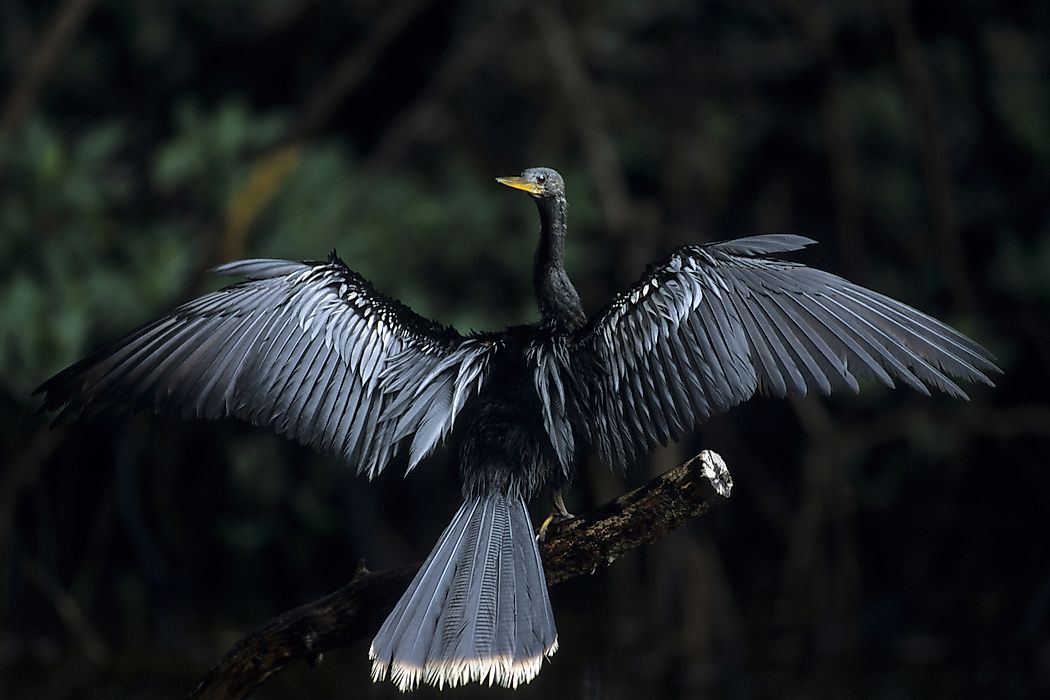Anhinga Facts: Animals of North America

5. Physical Description
The Anhinga is a larger bird species that ranges in length between 75 and 95 centimeters, and boasts a wingspan of up to 110 centimeters. Their large wing spans allow them to fly more akin to the flight characteristics of a hawk or vulture. They are sexually dimorphic, with females being more brown in contrast to the males' black colorings, and smaller. Their feathers have less buoyancy than ducks, allowing them to be able to dive under water, and they will also swim with their body under water with just their skinny necks sticking out above it, leading to their nickname the "snake bird".
4. Diet
The Anhinga eats medium to small-sized fish, as well as an assortment of aquatic crustaceans and insects. They are able to swim very low in the water due to their reduced buoyancy compared to other birds, which in turn allows them to stalk their prey, which is sometimes obscured from the surface by aquatic vegetation in the water.
3. Habitat and Range
The Anhinga can be found living as far north as the southeastern United States in warmer months, with a more permanent base in Mexico year-round. They migrate north during warmer weather, and are typically found living near slow-moving aquatic ecosystems, such as swamps and mangroves. The Anhinga is a migratory bird species whose range is contained within the Americas. They fly up north in the eastern United States to breed in the summer. There are permanent colonies in Florida and further south in Mexico and South America. The Anhinga is adapted to hunting in the slow-moving, shallow, warm waters found in swamps, marshes, and mangroves. They prefer sunshine and warm weather, and this consideration for temperature is the one on which they base their migratory patterns. The furthest north they have been found is in Pennsylvania and Wisconsin. They are not a protected species, and their conservation status has placed the Anhinga as a species of "least concern". Anhingas are sometimes used as pollution indicators for the wetland environments they live in, because they spend so much time in and around the water.
2. Behavior
The Anhinga is a darter, a species of fish-hunting birds. They are able to dive very low into the water and stalk their prey, and they strike quickly to catch their meals. Their beaks and necks have uniquely evolved for them to be able to do this. They are able to eat by then lifting their faces upwards and swallowing, so the fish can go down their long necks. They are not able to fly when their wings are wet, so they can be seen standing in the slow moving waters of a swamp with their wings outstretched to dry off so that they are able to take off. Their flight behaviors have caused people to describe them as "black paper gliders", because they do not have to flap their wings very often. The Anhinga lives and migrates not only with other members of their own species, but also with those of other species such as Herons and Cormorants, birds which they are often even mistaken for.
1. Reproduction
Reproduction within the Anhinga species begins with the male. He chooses a spot in the colony to nest, and then begins to try and attract a female. This is carried out by performing a dance which includes wing waving, looking up into the sky as they do when they are about to swallow their food, and then bowing down deeply towards the female. Once a female responds positively, she is given supplies by the male, which include sticks and green leaves to build their nest. The nests are always near water, usually in a tree overhanging it. There are usually between 2 and 5 eggs in each nest. Both parents alternate laying on the eggs for an incubation period of 25 to 29 days. There is little data to gives us a concrete time frame of when the young leave the nest and fly, though in most birds this occurs sometime between weaning age and their attainment of full sexual maturity.











